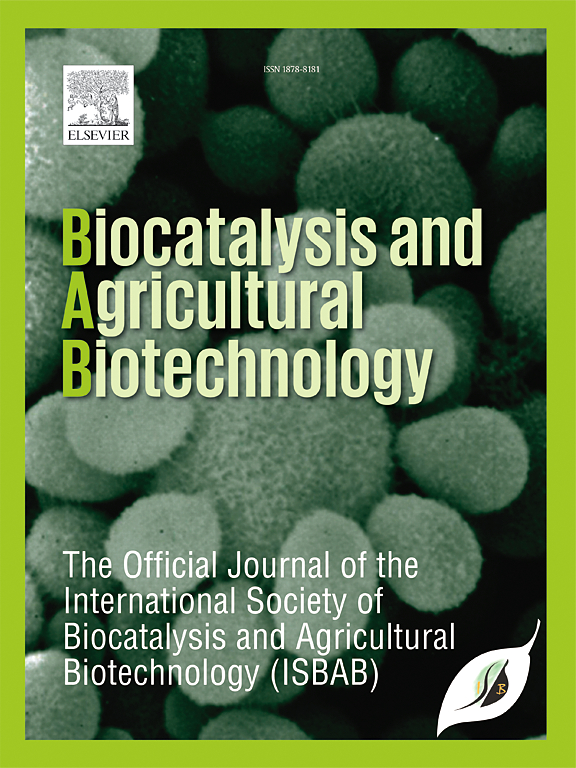Protective effects of hydroethanolic extract of Mentha longifolia L. leaves against hepato-renal toxicity induced by furan exposure: In vivo and In silico studies
IF 3.4
Q2 BIOTECHNOLOGY & APPLIED MICROBIOLOGY
引用次数: 0
Abstract
Furan is a potential human carcinogen that forms in certain processed foods at trace levels, typically in the nanogram per gram range. The present study aimed to explore the antioxidant and hepatorenal protective effects of a chemically characterized extract from Mentha longifolia (ML-extract) against furan-induced hepatorenal damage in rats. To determine the phenolic profile of ML extract, HPLC-DAD analysis was performed, and its antioxidant capacity was evaluated using the DPPH, ABTS, TAC, and RP assays. Twenty-four normal Wistar rats were divided into four experimental groups: a control group that received distilled water orally (10 mL/kg BW), a group treated exclusively with ML-extract (200 mg/kg BW), a group exposed only to furan (40 mg/kg/day BW), and a group exposed to furan while simultaneously receiving ML-extract. Serum samples were collected to measure renal biomarkers (urea, creatinine, and total protein) and hepatic biochemical parameters (ASAT, ALAT, ALP, and total bilirubin). Lipid markers such as triglycerides and total cholesterol were also assessed. Additionally, fresh organ samples were collected for histopathological analysis. Furthermore, molecular docking was performed using the major compounds in ML-extract to investigate their interactions with target proteins. The in vitro analyses demonstrated that the tested extract exhibited strong antioxidant activity, which correlated with its rich composition of phenolic compounds, particularly caffeic acid, ferulic acid, naringin, and rutin. Likewise, in vivo studies revealed that treatment with ML-extract, either alone or in combination with furan, effectively alleviated biochemical parameters. These included a significant increase in kidney biomarkers (total bilirubin and urea levels), hepatic enzyme levels (ALT, AST, ALP, and total protein), and disruptions in lipid profile (triglycerides and total cholesterol) compared to the control group. Furthermore, the extract contributed to the preservation of hepatic and renal functions, reinforcing its potential protective effects against furan-induced toxicity. Molecular docking analysis further demonstrated that bioactive compounds, such as 4-Hydroxybenzoic acid, ferulic acid, caffeic acid, sinapinic acid, hesperidin, rutin, naringin, and cinnamic acid, exhibited strong binding affinity in complex with hepatoprotective protein (3ANS) and antioxidant (5IKQ) proteins, supporting the experimental findings. In summary, these results suggest that the hydroethanolic extract of M. longifolia may serve as a potential therapeutic agent for preventing liver and kidney damage resulting from xenobiotic exposure.
长叶薄荷水乙醇提取物对呋喃暴露引起的肝肾毒性的保护作用:体内和体外研究
呋喃是一种潜在的人类致癌物,在某些加工食品中以微量含量形成,通常在每克纳克范围内。本研究旨在探讨薄荷提取物(ml提取物)对呋喃致大鼠肝肾损伤的抗氧化和保护作用。为了确定ML提取物的酚类成分,采用HPLC-DAD分析,并使用DPPH、ABTS、TAC和RP分析评估其抗氧化能力。将24只正常Wistar大鼠分为4个实验组:对照组口服蒸馏水(10 mL/kg BW)、纯mL -提取物组(200 mg/kg BW)、仅暴露于呋喃组(40 mg/kg/天BW)和暴露于呋喃同时接受mL -提取物组。采集血清样本,测定肾脏生物标志物(尿素、肌酐和总蛋白)和肝脏生化指标(ASAT、ALAT、ALP和总胆红素)。脂质标志物如甘油三酯和总胆固醇也被评估。此外,收集新鲜器官样本进行组织病理学分析。此外,利用ml提取物中的主要化合物进行分子对接,研究它们与靶蛋白的相互作用。体外分析表明,所测提取物具有较强的抗氧化活性,这与其丰富的酚类化合物组成有关,特别是咖啡酸、阿魏酸、柚皮苷和芦丁。同样,体内研究表明,ml提取物单独或与呋喃联合处理,都能有效地缓解生化参数。其中包括与对照组相比,肾脏生物标志物(总胆红素和尿素水平)、肝酶水平(ALT、AST、ALP和总蛋白)和脂质谱(甘油三酯和总胆固醇)的显著增加。此外,该提取物有助于保护肝脏和肾脏功能,加强其对呋喃引起的毒性的潜在保护作用。分子对接分析进一步证实,4-羟基苯甲酸、阿魏酸、咖啡酸、皂荚酸、橙皮苷、芦丁、柚皮苷、肉桂酸等生物活性化合物与肝保护蛋白(3ANS)和抗氧化蛋白(5IKQ)复合物具有较强的结合亲和力,支持实验结果。综上所述,这些结果表明,长叶参的氢乙醇提取物可能是一种潜在的治疗药物,可以预防外源性暴露引起的肝脏和肾脏损害。
本文章由计算机程序翻译,如有差异,请以英文原文为准。
求助全文
约1分钟内获得全文
求助全文
来源期刊

Biocatalysis and agricultural biotechnology
Agricultural and Biological Sciences-Agronomy and Crop Science
CiteScore
7.70
自引率
2.50%
发文量
308
审稿时长
48 days
期刊介绍:
Biocatalysis and Agricultural Biotechnology is the official journal of the International Society of Biocatalysis and Agricultural Biotechnology (ISBAB). The journal publishes high quality articles especially in the science and technology of biocatalysis, bioprocesses, agricultural biotechnology, biomedical biotechnology, and, if appropriate, from other related areas of biotechnology. The journal will publish peer-reviewed basic and applied research papers, authoritative reviews, and feature articles. The scope of the journal encompasses the research, industrial, and commercial aspects of biotechnology, including the areas of: biocatalysis; bioprocesses; food and agriculture; genetic engineering; molecular biology; healthcare and pharmaceuticals; biofuels; genomics; nanotechnology; environment and biodiversity; and bioremediation.
 求助内容:
求助内容: 应助结果提醒方式:
应助结果提醒方式:


